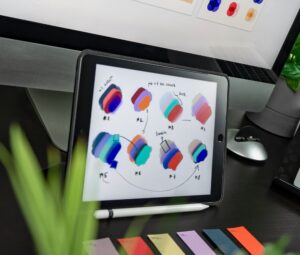It’s no secret that the internet is overflowing with cookie-cutter portfolio websites, especially in the design world. For graphic designers, your website is more than just an online portfolio. It’s your digital storefront, your personal brand statement, and your ultimate client magnet. But with so many similar templates and designs out there, standing out can be a real challenge.
Today, we’re sharing up-to-date strategies to help you design a website that stands out. This guide will teach you how to craft a unique graphic designer website that reflects your design expertise and personality.
Step 1: Define Your Strategy
A strong strategy is the foundation of a standout website. Begin by identifying your goals, target audience, and the unique value you bring as a graphic designer. Think beyond the aesthetics and focus on what makes your work, services, and process stand out.
Know Your ‘Why’ and ‘Who’
Before anything else, define your goals:
- Who is your target audience? Are you catering to startups, corporate clients, or niche brands? Knowing who you’re designing for will shape everything from your site’s tone to its layout.
- Why are you creating this website? Is it to attract freelance clients, land a corporate design role, or showcase your work to inspire others? Your purpose will influence your site’s content and design.
Uncover Your Unique Selling Proposition (USP)
To stand out, you’ve got to get clear on what makes you unique. Do you have a knack for something specific, like creating eco-friendly branding or mastering bold, eye-catching typography? Maybe your process is what sets you apart, whether it’s super innovative or built around close collaboration with your clients. Or perhaps you’re passionate about working with certain industries, like tech startups or nonprofits. Whatever it is, identifying your unique selling proposition (USP) is key.
Once you nail that down, make sure it shines through in your website’s messaging—it’s what will make people remember you.

Develop Your Brand Voice and Visuals
Your website should feel like a genuine reflection of who you are and what your brand stands for. Think of it as an extension of your personality and style. If you’re all about bold, quirky, vibrant designs, sprinkle in some playful animations to show that off. On the other hand, if clean, modern branding is your thing, keep things sleek and minimal.
The key is to stay consistent—when your design, tone, and visuals all line up with your professional identity, it helps people trust you and remember your brand.
Step 2: Curate Content That Tells Your Story
Your content is the heart of your online presence, and it should reflect who you are and what you stand for. By sharing authentic and meaningful stories, you create a genuine connection with your audience.
Quality Over Quantity
Your website doesn’t need to show every project you’ve ever worked on. Instead of overwhelming visitors, choose 5–8 of your strongest, most relevant pieces. Show work that demonstrates your expertise, creativity, and problem-solving skills.
Project Narrative
Don’t just display your work; tell its story. Clients want to know the “why” and “how” behind your designs. For each project, include:
- The Challenge: What problem were you solving?
- The Process: What steps did you take to solve it?
- Your Role: What was your specific contribution?
- The Outcome: What results did your design achieve?
Adding context makes your work more engaging and shows the strategic depth behind your visuals.
Showcase, Don’t Just Display
Think beyond the typical portfolio when showing off your work. Instead of just static images, why not include interactive mockups or before-and-after visuals to bring your designs to life? For more complex projects, adding a video walkthrough can help tell the full story and keep things engaging. Or, if you’ve got one standout project, turn it into a detailed case study that lets people immerse themselves in your process—your challenges, your problem-solving, and the amazing results you achieved.
Little touches like these can make your portfolio feel more dynamic, personal, and unforgettable.

An Authentic About Page
Many designers treat their “About Me” page as an afterthought. Don’t make the same mistake. This is a prime opportunity to connect with potential clients. Instead of a generic bio, share your design philosophy, values, and personality. What drives your passion for design? Who are you outside of work? Authenticity can turn casual browsers into loyal clients.
Step 3: Design an Experience, Not Just a Website
Your website itself should act as a portfolio piece. It needs to showcase your skills and creativity. Custom designs often have the most impact. Just make sure your website feels undeniably yours.
Creativity is essential, but never at the cost of usability. Even in creative design, user experience is non-negotiable. This means your website must have:
- Clear navigation with a logical flow.
- Responsiveness across all devices.
- Readable fonts and a well-organized layout.
Thoughtful animations, hover states, or scrolling effects can enhance your site’s engagement. However, use these selectively. Every interactive detail should serve a purpose and align with your brand.
Finally, have a mobile-first mentality. Over 50% of web traffic worldwide comes from mobile devices. Your website must look and function as beautifully on a smartphone as it does on a desktop. Test responsiveness rigorously to guarantee seamless performance.
Step 4: The Technical Stuff
Your website’s speed and performance are incredibly important. Did you know 40% of visitors abandon a website if it takes longer than 3 seconds to load? Optimize your site by:
- Compressing images without sacrificing quality.
- Reducing unnecessary plugins and scripts.
- Choosing a fast, reliable hosting provider.
Incorporate search engine optimization (SEO) to help people find your site. Target relevant keywords like “graphic designer website” and “graphic design in [your city]” in strategic places:
- Title tags
- Meta descriptions
- Alt text for images
- URL structures
- and naturally within your content
This improves your search engine ranking and gets your site in front of more potential clients.
Lastly, make sure your site is inclusive. This means it should be accessible for all potential visitors. Some easy steps include:
- Adding alt text to images for screen readers.
- Ensuring color contrast is sufficient for readability.
- Using keyboard-friendly navigation.
Website accessibility broadens your audience while reflecting positively on your brand. Plus, in some places, it’s required by law.

Bring Your Unique Vision to Life
Building a standout website takes time and effort, especially when balancing client work with personal branding. But you don’t have to do it alone. Moonlit Media can help. We specialize in custom website design and development for creative professionals like you. From strategy and design to technical optimization and SEO, we do it all.
Ready to showcase your talent with a website as unique as your work? Contact us for a consultation. Together, we’ll create a site that looks stunning and also gets you noticed.








